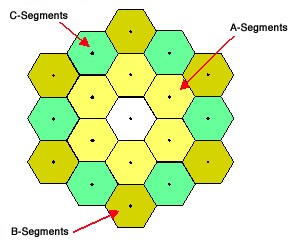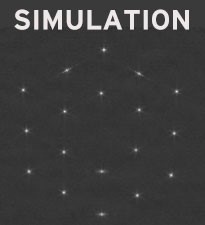This week, the three-month process of aligning the telescope began – and over the last day, Webb team members saw the first photons of starlight that traveled through the entire telescope and were detected by the Near Infrared Camera (NIRCam) instrument. This milestone marks the first of many steps to capture images that are at first unfocused and use them to slowly fine-tune the telescope. This is the very beginning of the process, but so far the initial results match expectations and simulations.
A team of engineers and scientists from Ball Aerospace, Space Telescope Science Institute, and NASA’s Goddard Space Flight Center will now use data taken with NIRCam to progressively align the telescope. The team developed and demonstrated the algorithms using a 1/6th scale model telescope testbed. They have simulated and rehearsed the process many times and are now ready to do this with Webb. The process will take place in seven phases over the next three months, culminating in a fully aligned telescope ready for instrument commissioning. The images taken by Webb during this period will not be “pretty” images like the new views of the universe Webb will unveil later this summer. They strictly serve the purpose of preparing the telescope for science.
To work together as a single mirror, the telescope’s 18 primary mirror segments need to match each other to a fraction of a wavelength of light – approximately 50 nanometers. To put this in perspective, if the Webb primary mirror were the size of the United States, each segment would be the size of Texas, and the team would need to line the height of those Texas-sized segments up with each other to an accuracy of about 1.5 inches.
Scott Acton and Chanda Walker of Ball Aerospace, along with Lee Feinberg of NASA Goddard, walk through the basic steps below:
“With deployment of the mirror segments now complete, and the instruments turned on, the team has begun the numerous steps required to prepare and calibrate the telescope to do its job. The telescope commissioning process will take much longer than previous space telescopes because Webb’s primary mirror consists of 18 individual mirror segments that need to work together as a single high-precision optical surface. The steps in the commissioning process include:
-
-
- Segment Image Identification
- Segment Alignment
- Image Stacking
- Coarse Phasing
- Fine Phasing
- Telescope Alignment Over Instrument Fields of View
- Iterate Alignment for Final Correction
-
1. Segment Image Identification
First, we need to align the telescope relative to the spacecraft. The spacecraft is capable of making extremely precise pointing moves, using “star trackers.” Think of star trackers as a GPS for spacecraft. At first, the position of the spacecraft from the star trackers does not match the position of each of the mirror segments.
We are pointing the telescope at a bright, isolated star (HD 84406) to capture a series of images that are then stitched together to form a picture of that part of the sky. But remember, we don’t have just one mirror looking at this star; we have 18 mirrors, each of which is initially tilted towards a different part of the sky. As a result, we’ll actually capture 18 slightly shifted copies of the star – each one out of focus and uniquely distorted. We refer to these initial star-copies as “segment images.” In fact, depending on the starting positions of the mirrors, it may take multiple iterations to locate all 18 segments in one image.

One by one, we will move the 18 mirror segments to determine which segment creates which segment image. After matching the mirror segments to their respective images, we can tilt the mirrors to bring all the images near a common point for further analysis. We call this arrangement an “image array.”
2. Segment Alignment
After we have the image array, we can perform Segment Alignment, which corrects most of the large positioning errors of the mirror segments.
We begin by defocusing the segment images by moving the secondary mirror slightly. Mathematical analysis, called Phase Retrieval, is applied to the defocused images to determine the precise positioning errors of the segments. Adjustments of the segments then result in 18 well-corrected “telescopes.” However, the segments still don’t work together as a single mirror.
3. Image Stacking
To put all of the light in a single place, each segment image must be stacked on top of one another. In the Image Stacking step, we move the individual segment images so that they fall precisely at the center of the field to produce one unified image. This process prepares the telescope for Coarse Phasing.
The stacking is performed sequentially in three groups (A-segments, B-segments, and C-segments).


4. Coarse Phasing
Although Image Stacking puts all the light in one place on the detector, the segments are still acting as 18 small telescopes rather than one big one. The segments need to be lined up with each other with an accuracy smaller than the wavelength of the light.
Conducted three times during the commissioning process, Coarse Phasing measures and corrects the vertical displacement (piston difference) of the mirror segments. Using a technology known as Dispersed Fringe Sensing, we use NIRCam to capture light spectra from 20 separate pairings of mirror segments. The spectrum will resemble a barber pole pattern with a slope (or angle) determined by the piston difference of the two segments in the pairing.

5. Fine Phasing
Fine Phasing is also conducted three times, directly after each round of Coarse Phasing, and then routinely throughout Webb’s lifespan. These operations measure and correct the remaining alignment errors using the same defocusing method applied during Segment Alignment. However, instead of using the secondary mirror, we use special optical elements inside the science instrument which introduce varying amounts of defocus for each image (-8, -4, +4, and +8 waves of defocus).

6. Telescope Alignment Over Instrument Fields of View
After Fine Phasing, the telescope will be well aligned at one place in the NIRCam field of view. Now we need to extend the alignment to the rest of the instruments.
In this phase of the commissioning process, we make measurements at multiple locations, or field points, across each of the science instruments, as shown below. More variation in intensity indicates larger errors at that field point. An algorithm calculates the final corrections needed to achieve a well-aligned telescope across all science instruments.

7. Iterate Alignment for Final Correction
After applying the Field of View correction, the key thing left to address is the removal of any small, residual positioning errors in the primary mirror segments. We measure and make corrections using the Fine Phasing process. We will do a final check of the image quality across each of the science instruments; once this is verified, the wavefront sensing and controls process will be complete.
As we go through the seven steps, we may find that we need to iterate earlier steps as well. The process is flexible and modular to allow for iteration. After roughly three months of aligning the telescope, we will be ready to proceed to commissioning the instruments.”
—Scott Acton, Webb lead wavefront sensing and control scientist, Ball Aerospace; Chanda Walker, Webb wavefront sensing and control scientist, Ball Aerospace; and Lee Feinberg, Webb optical telescope element manager, NASA’s Goddard Space Flight Center


